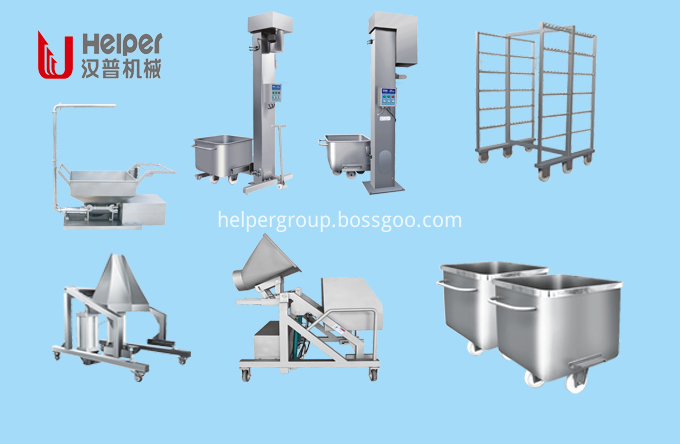Peripheral Devices and Consumables
Based on the low labor cost and reasonable stainless steel cost, Helper help to offer clients internal transport devices with best price. These machines and device include standard material truck, smoking trolley, lifter, conveyer belts, spiral feeding machine, hydraulic lifter etc. The internal transport device is used in filling and forming workshop, tumbling and seasoning workshop, smoking and cooking room etc.
Helper has a professional team to design and produce sausage clips. They have rich experience and understand all the key points for produce good quality clips. From the raw material purchasing to mould designing, from the QC in production to post-treatment, they pay attention to all these details that lead to the good quality of Helper`s clip series. Our clips products include U shape clips, Great wall shape clips, and aluminum wire (for aluminum wire clipper).
U Shape Sausage Clip,Clips On Strip,Bag Packaging Clips,Screw Material Conveyor Helper Machinery Group Co., Ltd. , https://www.ihelpergroup.com

The difference between analog oscilloscopes and digital oscilloscopes in simple repetitive signals
An oscilloscope is a widely used electronic measurement tool that transforms invisible electrical signals into visible waveforms, enabling users to analyze and understand various electrical phenomena. Oscilloscopes are typically divided into two main types: analog and digital (DSO). Let’s explore the differences between them when observing simple repetitive signals.
Simple repetitive signals can be effectively analyzed using both analog oscilloscopes and digital storage oscilloscopes (DSOs). However, each has its own strengths and limitations. Analog oscilloscopes may struggle to display very low-frequency signals due to the short afterglow of the CRT screen. The brightness of the trace on an analog scope is inversely related to the scan speed, making it difficult to observe signals with slow repetition rates but fast rise and fall times. In contrast, DSOs have independent sweep brightness and scan speed from the signal’s repetition rate, which can be either beneficial or limiting depending on the situation.
When dealing with fast edges in repetitive signals that have a high enough repetition rate, the performance of both DSOs and analog oscilloscopes is quite similar. In such cases, both devices can clearly display the waveform.
One key advantage of DSOs is their ability to automatically measure signal parameters. With analog oscilloscopes, users must manually adjust cursors and analyze the waveform to obtain measurements, which can be time-consuming and less precise.
For real-time adjustments, analog oscilloscopes are often preferred. This is because they provide a continuous, real-time display of the input voltage. Their waveform update rate is extremely high—often over 100,000 scans per second at high speeds. As a result, any changes in the signal are immediately visible on the screen. Additionally, small variations in the signal may appear as changes in the brightness of the waveform.
On the other hand, DSOs reconstruct waveforms from sampled data. The number of waveform acquisitions per second is significantly lower, sometimes just a few times per second. This delay means that changes in the signal may not appear on the screen immediately, which can be a major disadvantage when fine-tuning a system.